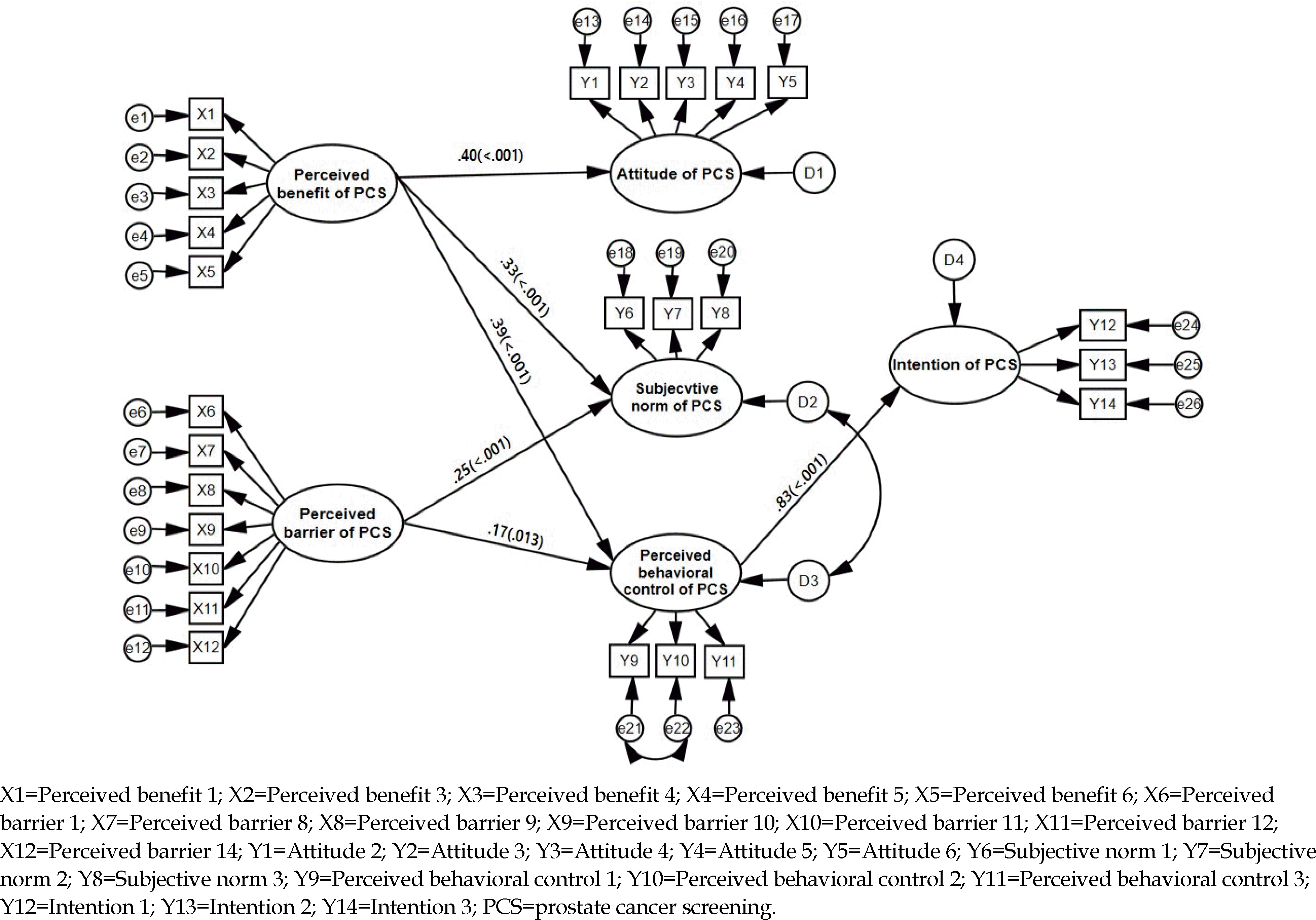Abstract
Purpose
The purpose of this study was to identify factors associated with the intention of the prostate cancer screening (PCS). To achieve this purpose, a structural equation model was established based on the health belief model and the theory of planned behavior.
Methods
The subjects of this study were 260 male participants who were between 40 and 74 years old and had not taken the PCS. Data were collected using a structured self-report questionnaire (i.e., perceived benefits, perceived barriers, attitude, subjective norms, perceived behavior control, and intention of the PCS). Descriptive statistics, reliability analysis, correlation analysis, confirmatory factor analysis, and fitness test were used to test hypotheses.
Go to : 
References
1. Korea Central Cancer Registry. National Cancer Center. Annual report of cancer statistics in Korea in 2016. Annual Report. Goyang: Ministry of Health and Welfare;2018. December. Report No.: 11-1352000-000145-10.
2. Han JH, Yoon SJ, Lee YG. Background and validity of the promotion of prostate-specific antigen based prostate cancer screening to national cancer screening program. The Korean Journal of Urological Oncology. 2010; 8(1):1–9.
3. Oliver JS, Grindel CG, DeCoster J, Ford CD, Martin MY. Benefits, barriers, sources of influence, and prostate cancer screening among rural men. Public Health Nursing. 2011; 28(6):512–522. https://doi.org/10.1111/j.1525-1446.2011.00956.x.

4. Lee EN, Park JH, Kang SG, Yun S, Sin KM, Kim KM. Factors affecting prostate cancer screening behavior. Asian Oncology Nursing,. 2015; 15(4):256–263. https://doi.org/10.5388/aon.2015.15.4.256.

5. Berglund G, Nilsson S, Nordin K. Intention to test for prostate cancer. European Journal of Cancer. 2005; 41(7):990–997. https://doi.org/10.1016/j.ejca.2005.01.011.

6. Hevey D, Pertl M, Thomas K, Maher L, Chuinneagain SN, Craig A. The relationship between prostate cancer knowledge and beliefs and intentions to attend PSA screening among at-risk men. Patient Education and Counselling. 2009; 74(2):244–249. https://doi.org/10.1016/j.pec.2008.08.013.

7. Odedina FT, Campbell ES, LaRose-Pierre M, Scrivens J, Hill A. Personal factors affecting African-American men's prostate cancer screening behavior. Journal of the National Medical Association. 2008; 100(6):724–733. https://doi.org/10.1016/s0027-9684(15)31350-x.

8. Barati M, Bashirian S, Amirzarghar MA, Mousali A, Saatiasr MH. Prostate cancer screening behaviors and its related cognitive psychological factors among men over 50 years of age using the health belief model. Journal of Hayat. 2018; 23(4):345–357.
9. Becker MH. The health belief model and personal health behavior. Health Education Monograph. 1974; 2:324–508.
10. Ajzen I. The theory of planned behavior. Organizational Behavioral and Human Decision Processes. 1991; 50(2):179–211. https://doi.org/10.1016/0749-5978(91)90020-T.

11. Glanz K, Rimer BK, Lewis FM. Health behavior and health education. 3th ed. Yoo TK. Seoul: Gunza;2012. p. 612.
12. Yang ZJ. Predicting young adult's intentions to get the H1N1 vaccine: An integrated model. Journal of Health Communication. 2015; 20(1):69–79. https://doi.org/10.1080/10810730.2014.904023.

13. Gerend MA, Shephred JE. Predicting human papillomavirus vaccine uptake in young adult women: comparing the health belief model and theory of planned behavior. Annal of Behavioral Medicine. 2012; 44(2):171–180. https://doi.org/10.1007/s12160-012-9366-5.

14. Lee BK, Sohn YK, Lee SL, Yoon MY, Kim MH, Kim CR. An efficacy of social cognitive theory to predict health behavior: A meta-analysis on the health belief model studies in Korea. Journal of Public Relations. 2014; 18(2):163–206.
15. Ajzen I. Attitudes, personality and behavior. 2nd ed. England Milton-Keynes: McGraw-Hill;2005.
16. Ju HJ, Lee JH. Structural relationship of variables regarding nurse's preventive action against needle stick injury. Journal of Korean Academic Society of Nursing Education. 2015; 21(2):168–181. https://doi.org/10.5977/jkasne.2015.21.2.168.

17. Lee SJ, Park OK, Park MY. A structural equation model of pressure ulcer prevention action in clinical nurses. Journal of Korean Academy of Nursing. 2016; 46(6):572–582. https://doi.org/10.4040/jkan.2016.46.4.572.

18. Carter HB, Albertsen PC, Barry MJ, Etzioni R, Freedland SJ, Greene KL, et al. Early detection of prostate cancer: AUA guideline. The Journal of urology. 2013; 190(2):419–426. https://doi.org/10.1016/j.juro.2013.04.119.

19. The Korean Journal of Urological Oncology. Prostate cancer guideline [Internet]. Seoul: The Korean Journal of Urological Oncology;2015. [cited 2018 December 01]. Available from:. http://www.kuos.or.kr/data/sub05.html#.
20. Yu JP. The concept and understanding of structural equation modeling. Seoul: Hannare Publishing Co;2016. p. 567.
21. Çapik C, Gözüm S. Development and validation of health beliefs model scale for prostate cancer screenings (HBM-PCS): Evidence from exploratory and confirmatory factor analyses. European Journal of Oncology Nursing. 2011; 15(5):478–485. https://doi.org/10.1016/j.ejon.2010.12.003.

22. Ajzen I. Constructing a TPB questionnaire: Conceptual and methodological considerations. United States: Icek Ajzen;2010. [cited 2018 December 01]. Available from:. https://people.umass.edu/aizen/tpb.html.
23. Hahm MI, Choi KS, Kye SY, Kwak MS, Park EC. Factors influencing the intention to have stomach cancer screening. Journal of Preventive Medicine and Public Health. 2007; 40(3):205–212. https://doi.org/10.3961/jpmph.2007.40.3.205.

24. Kim RB, Park KS, Hong DY, Lee CH, Kim JP. Factors associated with cancer screening intention in eligible persons for national cancer screening program. Journal of Preventive Medicine and Public Health. 2010; 43(1):62–72. https://doi.org/10.3961/jpmph.2010.43.1.62.

25. Kim WP. The Structural equation modeling analysis. Seoul: Wise in Company Co;2017. p. 478.
26. Kang MJ, Lee MS. Integrating the precaution adoption process model and the health belief model to assess cancer screening readiness among Korean adults. Korean Journal of Health Education and Promotion. 2011; 28(3):83–98.
27. Fishbein M, Yzer MC. Using theory to design effective health behavior interventions. Communication Theory. 2003; 13(2):164–183. https://doi.org/10.1111/j.1468-2885.2003.tb00287.x.

28. Lee YJ. A study of effect of health belief on health information processing and health behavior intention [dissertation]. [Seoul]: Hanyang University;2013. p. 198.
29. Bae PW. Suh SR. Predictive factors on breast self-examination intention and behavior in middle aged women: Based on the theory of planned behavior. Journal of the Korea Academia-Industrial cooperation Society. 2013; 14(5):2349–2359. https://doi.org/10.5762/KAIS.2013.14.5.2349.
Go to : 
Table 1.
General Characteristics of the Subjects (N=260)
Table 2.
Descriptive Statistics of the Main Variables (N=260)
Table 3.
Confirmatory Factor Analysis and Correlation Matrix (between measure variables) (N=260)
Table 4.
Effects of Predictor Variables on Endogenous Variables for Modified Model (N=260)




 PDF
PDF ePub
ePub Citation
Citation Print
Print



 XML Download
XML Download